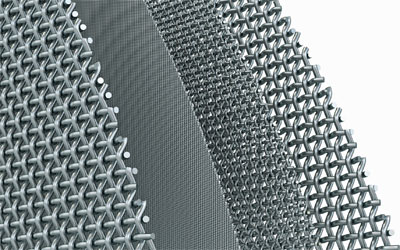| Plastics News |
At Fakuma 2018, Nordson launches new multi-layer screen packs for melt filtration
September 24, 2018: New screen packs for BKG® screen changers from Nordson Corporation effectively withstand the pressures of extrusion, providing maximum filtration and optimum melt flow while ensuring a longer working life and greater reliability than low-end screen packs on the market, the company claims. Nordson will introduce the screen packs at Fakuma 2018 (Booth A6-6109). According to the company, one key to the enhanced performance of the new screen packs is a robust multi-layer structure that prevents failures caused by the pressure differential—up to 200 bar—encountered during filtration. One such failure is “screen dimpling,” in which the mechanical stress forces screen layers into the holes of the breaker plate that supports the screen in the cavity. This distorts the screen, breaking the peripheral seal and causing contaminants to bypass the screen and become part of the end product. Nordson says that it precisely tailors the size of the screen pack to the dimensions of the cavity, eliminating the common problem of contaminant passing the screen pack at the edges. In addition, all screen pack components are ultrasonically pre-cleaned during manufacture to eliminate contamination from the oil and grease used in the weaving process. “The new Nordson screen pack design maintains structural integrity while efficiently filtering out contaminants and ensuring optimal melt permeability,” said Christian Schroeder, global product manager for melt delivery systems. “As a result, our screen pack yields more output between screen changes than screen packs offered as low-cost alternatives, increasing the productivity of the extrusion line and enhancing profitability.” Depending on customer requirements, Nordson supplies the screen packs with different layer combinations. One common structure, for example, has four layers, including two coarse square-weave layers that serve as the outer components and a finer internal square-weave layer. These provide support and drainage functions and withstand high tensile forces, says Nordson. The fourth layer is an optimized Dutch weave wire mesh that serves as the fine filtration component. The small geometric pore size of the Dutch weave layer ensures high permeability. Filtration takes place crosswise with respect to the direction of melt flow, enabling dirt particles to be separated from the melt. “A key factor for efficient filtration is permeability,” said Stefan Woestmann, application engineer. “The Nordson screen pack provides the optimum ratio of solid material and free volume, so that the polymer melt can use as many flow paths as possible to make its way through the filtration medium. In processes with low-end screens, which are not flow-optimized in this way, polymer melt builds up and causes a significant increase in pressure. This leads to premature and costly screen changes and endangers the quality of the end product. If the polymer flow is not uniform, the end product cannot be either.” Founded in 1954 and headquartered in Westlake, Ohio, Nordson Corporation has operations and support offices in more than 30 countries. Nordson Polymer Processing Systems provides customers with engineered components to melt, homogenize, filter, meter, and give shape to plastic and fluid coating materials. Nordson delivers a full range of precision melt stream products — from screws and barrels for extrusion and injection molding — to filtration systems, pumps, and valves — to the extrusion dies and pelletizing systems to meet the constantly evolving needs of the polymer industry. Source: Nordson |


